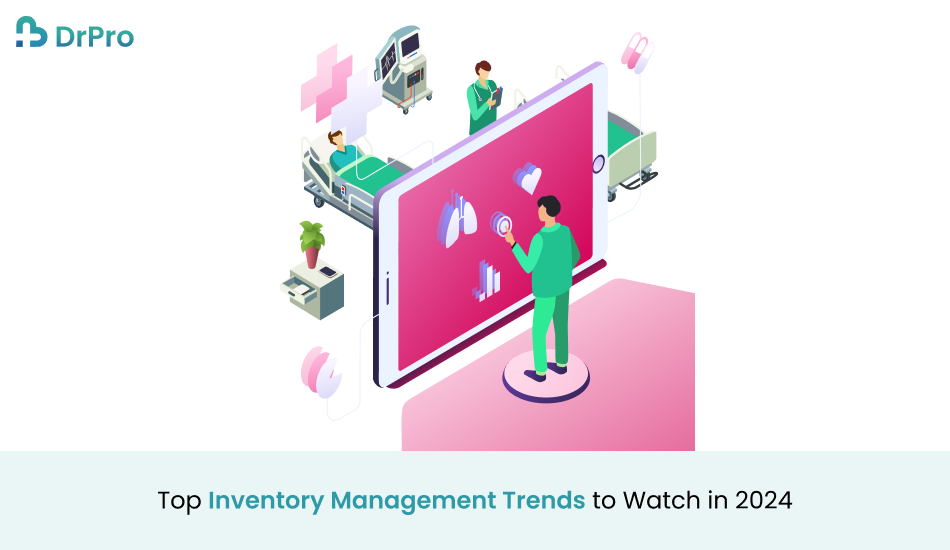Inventory management is important for any successful company, as it ensures the availability of goods at the right time and decreases waste and inefficiency. These advances in technology and boosting consumer needs led to major changes in tracking inventory, management, and optimization. As we approach 2024, new trends emerge, altering the face of inventory management for businesses of every size.
The main trends in inventory management for 2024 will be covered in this article, with a focus on how the advances might advance excellence in operation and help companies. Whether you’re a small company or an enormous company, keeping ahead of the latest developments and using the most recent inventory management software system will significantly boost your profitability and efficiency.
1. Artificial Intelligence (AI) and Machine Learning Integration
Inventory management is only one among the numerous industries that artificial intelligence (AI) continues to transform. AI and machine learning are expected to have a growing part in processes for inventory management by 2024, providing organizations with the tools required to make decisions based on data. Intelligence may more accurately determine demand through studying data on inventory patterns, reducing overstocking and shortage.
Automatically changing points of reorder as well as security stock levels according to sales patterns, changes in the seasons, and other relevant standards based on artificial intelligence systems can aid in optimizing inventory. This ability allows firms to fine-tune their inventory levels in real-time, minimizing the possibility of revenue loss and overstock. Artificial intelligence systems develop as time goes on, so firms that employ AI inventory management software will see their operations become more exact and effective the longer they use the software.
2. IoT and Smart Inventory Management
There is another technology that will also influence future inventory management, and this is the Internet of Things (IoT). Examples of IoT devices are smart shelves and sensors, which will enable businesses to have an updated picture of their stock and location. They can order stock and provide notifications when items are out of stock, thus avoiding frequent physical counting of stock.
Smart shelves have the ability to track the amount of goods that are accessible while sending current information to the central inventory management system. Also, IoT sensors may help prevent loss by detecting fluctuations in temperature, humidity, or other outside factors that might damage fragile goods like food that is perishable or gadgets. The combination of IoT with inventory management software systems leads to a more reduced and controlled process, reducing human error and increasing the precision of inventory.
3. Cloud-Based Inventory Management Software

Cloud-based inventory management software systems are shown to take over as companies move to a more digital focus. Such systems have many benefits over standard premises software, such as real-time data access, greater scalability, and enhanced communication across divisions or regions. Businesses can use systems based on the cloud to access inventory information from anywhere, at any time, and on a range of devices.
Cloud-based inventory management software is also easy to connect with other company applications, including e-commerce platforms, accounting programs, and customer relationship management (CRM) systems. Its effortless communication improves transparency across divisions, allowing organizations to be more efficient and creative. Furthermore, cloud-based applications offer updates on their own, ensuring that companies always use the latest and most recent capabilities and developments without the need of manually installing or updating.
4. Blockchain for Supply Chain Transparency
Supply chain management and inventory management have seen significant developments in the application of blockchain technology, it is most commonly known for its role in coins. Companies are likely to employ blockchain more frequently to improve accountability and traceability throughout their supply chains. Blockchain provides for the safe and open recording of actions, culminating in an immutable the past of goods movement from producer to end consumer.
This technology can be especially valuable to firms that deal with complex supply chains with multiple vendors or agents. Companies can employ blockchain to trace and verify each stage of the supply chain, reducing the risk of fraud, imitations, and illegal activities. As well, blockchain can increase consumer confidence in the reliability and worth of the things they buy. The ability to trace products directly to their source has grown increasingly vital for businesses such as drugs, food and beverages, and expensive items.
5. Sustainability and eco-friendly inventory practices
Sustainability is becoming the primary objective for companies across the world in reaction to increasing concerns about the environment. More businesses are expected to adopt environmentally friendly inventory management strategies due to both customer demand and government mandates. It includes removing excess inventory, enhancing routes for transportation to save emissions, and minimizing waste from packaging.
To track and manage their environmental impact, a lot of companies are now investing in DrPro‘s inventory management software systems. Such systems can provide information about the environmental effects of inventory decisions, enabling companies to make decisions that are more environmentally friendly. For instance, solutions powered by AI could suggest different vendors or goods with reduced impact on the environment, while IoT devices can monitor the consumption of energy in depots or manufacturing facilities.
Furthermore, the supply chain models that maintain a model of circularity and repair, reuse, or recover things are growing more popular. Inventory management systems have grown to support such designs, enabling groups to effectively monitor and handle abandoned or reused products within their total stock.
6. Omnichannel Inventory Management
Modern organizations have to use multichannel inventory management due to the development of the internet and changing demands from consumers. In 2024, additional companies are going to concentrate on providing seamless purchases across multiple platforms, such as Internet shops, physical shops, and mobile apps. Multichannel inventory management ensures that customers can get products via the channels that they prefer while maintaining stock information correctly and up to date.
As such, to enhance inventory control in an omnichannel context or environment, a business requires an inventory management system that is capable of updating such an inventory in real time across all sales channels. Stock control synchronizes with trade to minimize instances where the stock is sold out or there is no stock to sell to customers hence ensuring that customers are satisfied and hence increasing their loyalty. Moreover, omnichannel inventories enable organizations to provide customers with various fulfillment opportunities, including BOPIS or ship-from-store, which increases the latter’s convenience.
7. Automated Warehouse and Robotics
The application of automation in warehouses is not new but it’s predicted this year more companies will implement automation in their warehouses. Robots and automation technologies can be used in performing activities that are cyclical and time-consuming in nature, of example, sorting, packing, and picking of products. It enables the firms to attain greater efficiency by reducing the human input in their warehouses while ensuring that the costs of labor are reduced dramatically as well as minimizing the possibilities of human mistakes.
If automated warehouses are combined with an advanced inventory management software system, fulfilling orders becomes more accurate and faster. Robots may be designed to help people with heavy lifting or high-precision activities as people dedicate themselves to more complicated issues or interacting with clients. Furthermore, automation increases the utilization of warehouse space by enabling more flexible and dynamic storage designs that can be changed in response to present inventory levels and demand for goods.
8. Demand Forecasting and Predictive Analytics
Forecasting demand remains an important part of inventory management, but firms will rely even more on predictive analytics to optimize their inventory. Predictive analytics accurately forecasts demand in the future by using past data, consumer buying patterns, and outside variables like market trends or seasonal variations.
Thus, inventory management systems integrated with predictive analytics capabilities are capable of preventing stockouts and overstocks by suggesting the most suitable inventory quantities with regard to the forecasted fluctuations in sales. This capability is useful to most companies as they cope with variability, for instance, retail stores during festive seasons or producers adapting to consumers’ dynamic tastes. Analyzing the data allows the organization to make better decisions on when to reorder the products and which products to order, the required inventory levels, and the correct utilization of resources.
9. Mobile Inventory Management Solutions
The rise of mobile technology is making inventory management more easily accessible and flexible to groups of all sizes. Mobile inventory management solutions, which enable staff to track inventory from their mobile devices, are expect to rise in use . Such mobile apps offer the ease of real-time inventory tracking, order management, and stock changes without requiring a computer with a desktop.
Mobile inventory solutions are the most advantageous for organizations with several stores or branches and field staff, as these users can retype the inventory data irrespective of their locations. Further, the application of mobile solutions enhances the coordination between teams and enhances my response time to support decision-making and problem-solving to the organizational goals. The effective incorporation of mobile functionality into an inventory management software system helps give business organizations the mobility they require if the market is dynamic or if operations are difficult.
Conclusion
Inventory management is changing quickly as 2024 draws near, thanks to new technologies and changing market conditions. With AI to digital currency and mobile solutions, these advances are changing how firms manage inventory and improve supply chains. Companies that adopt an innovative inventory management software system may stay competitive, reduce costs, and exceed demands from customers.
It is vital for organizations who want to improve their inventory management strategies stay ahead of such trends. DrPro, an expert in providing innovative solutions, offers a comprehensive inventory management software system built to satisfy the demands of modern competitive market. DrPro may help organizations optimize their supply chains, increasing productivity, and achieving long-term profitability through the use of modern technology.
With ProjectTree and DrPro working together, clients benefit from an integrated solution that bridges the gap between project management and medical practice
FAQs
Q1. What is an inventory management software system?
An inventory management software system is an application that enables a business to control its stock, orders, sales, and deliveries. This serves to present actual-time information and intelligence as a way to enhance stock administration and decrease expenses in an organization.
Q2. How can AI improve inventory management?
AI improves warehouse management by determining the demand for stock in the future, determining the right amount of stock required, and automating the reordering function. This uses historical data and trends to provide accurate forecasts with a view to reducing stock control problems such as excessive stock or stock-out situations.
Q3. What are the benefits of using cloud-based inventory management solutions?
The advantages of cloud-based inventory management include the availability of data that is as current as the time it is being used, the expansibility of the software to accommodate the growing needs of businesses, compatibility and integration with other tools, and self-updating.
Q4. How does IoT technology impact inventory management?
By using IoT, different items and other commodities within the business can be detected and tracked through smart devices and sensors to know their status and availability in real-time. These automations enable the reduction of manual tracking errors, increased accuracy, and overall improved visibility of inventories.
Q5. Why is sustainability important in inventory management?
Sustainability in inventory management is a way of preventing waste, lowering the impact that products have on the environment, and responding to the demands that customers have placed on reducing environmental impact.


